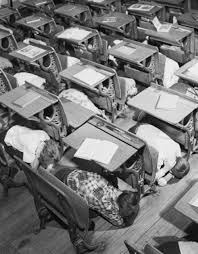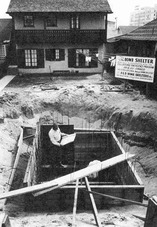
I grew up during the era of spies and double agents, Nikita Khrushchev, the Berlin Wall, the threat of nuclear war and the ongoing Cold War. Since the 1950s there had been many plane hijackings diverting to Miami and even up to Jacksonville. As a Florida resident "THE BOMB" was a close reality with Havana being only 90 miles from Key West. The threat of attack compelled communities to plan Civil Defense drills and neighborhoods, schools, and churches developed evacuation procedures.

We started practicing duck and cover drills in public school about as often as fire drills. Our elementary school was designed as rows of separated classrooms and each room had a complete back wall of windows. Can you imagine we thought we would be protected by covering our heads? We were not to look at the flash, and immediately duck and cover like "Bert the Turtle." We were to move away from the windows and get under our school desks. I don't think we discussed in detail what to do if we were at recess or walking home when the bomb dropped. The reality and consequences of radiation damage weren't discussed and as an elementary aged kid the drills just became routine.
We also had evacuation drills. The county plan was that since we were so close to Cuba, in the event of an attack it would be best for Florida residents to move north towards Georgia. When the Civil Defense alarm went off - a really loud piercing sound that pealed through the neighborhood routinely - we were to calmly and orderly walk out of the school, down through a small wooded area to a nearby road and board school buses that would miraculously arrive just in time to take us away. This plan had many flaws. Parents were rightly concerned that they would never be able to find their children - no cell phones in this day! Siblings would be separated. What about the family members left nearby at home or away at work? What about the beloved pets? Food, clothing, shelter? There were more questions than logical answers.
We also had evacuation drills. The county plan was that since we were so close to Cuba, in the event of an attack it would be best for Florida residents to move north towards Georgia. When the Civil Defense alarm went off - a really loud piercing sound that pealed through the neighborhood routinely - we were to calmly and orderly walk out of the school, down through a small wooded area to a nearby road and board school buses that would miraculously arrive just in time to take us away. This plan had many flaws. Parents were rightly concerned that they would never be able to find their children - no cell phones in this day! Siblings would be separated. What about the family members left nearby at home or away at work? What about the beloved pets? Food, clothing, shelter? There were more questions than logical answers.

In 1961 President Kennedy asked Congress for over $100 million to build public fallout shelters. This validated that point that evacuation was unrealistic, and the construction of home shelters skyrocketed. The concept was IF you could make it to the shelter before or immediately when the blast came, you would survive the radiation fallout if you were properly protected for the next two to four weeks.

It was revealed many years after the Cold War in the 1970s that a special bomb shelter had been built for President Kennedy on Peanut Island, FL. It had walls of lead and steel and it's codename was "Detachment Hotel." The location was near his family retreat in Palm Beach and could quickly be reached by helicopter. Though the building is showing its age, it is a popular tourist stop for many. As an aside, there are supposedly three feral cats living on the island near the bunker - Jack, Jackie, and Marilyn. Kennedy also had a bomb shelter constructed on Nantucket, but it has not been opened to the public.

There was room in most people's suburban back yards to dig great holes or add a structure. I only recall two neighbors with bomb shelters. The elderly family across the street from us built an above ground aluminum sided building which looked a lot like a storage shed of today. It was small, hence, only the three members of their family would be locked away when the bomb came. For this reason, they didn't advertize their shelter, but we did get the grand tour, viewing the cots, jugs of water, blankets, canned food, portable radio, and flashlights. Our other neighbor's shelter was more spacious and 3/4 underground. They had a larger family and needed more cot space. There was some type of air filter and a periscope which was really neat. There was a toilet of sorts which would be treated with chemicals. For the rest of us without shelters, we just gathered our usual hurricane supplies - empty bleach bottles filled with water, batteries, candles, and canned food. And always a can opener.

Over time most home shelters gave way to age, flooding, and decay. Some home buyers have been surprised to find an old ground entrance in their backyards, from as far as California to Wisconsin. Museums have accepted the aged items found in shelters, such as water barrels and cracker boxes, to add to displays of life during the Cold War. One family in Fort Meyers, FL continues to use their shelter as a hurricane get away and storeroom.
Do you have a Cold War memory?
"For in the day of trouble he will keep me safe in his dwelling;
he will hide me in the shelter of his sacred tent and set me high upon a rock." Psalm 27:5
Do you have a Cold War memory?
"For in the day of trouble he will keep me safe in his dwelling;
he will hide me in the shelter of his sacred tent and set me high upon a rock." Psalm 27:5




 RSS Feed
RSS Feed
